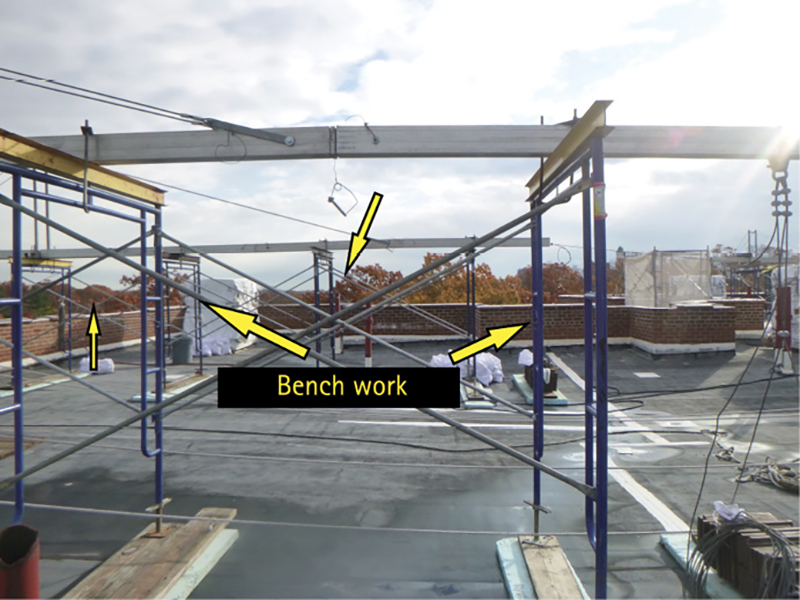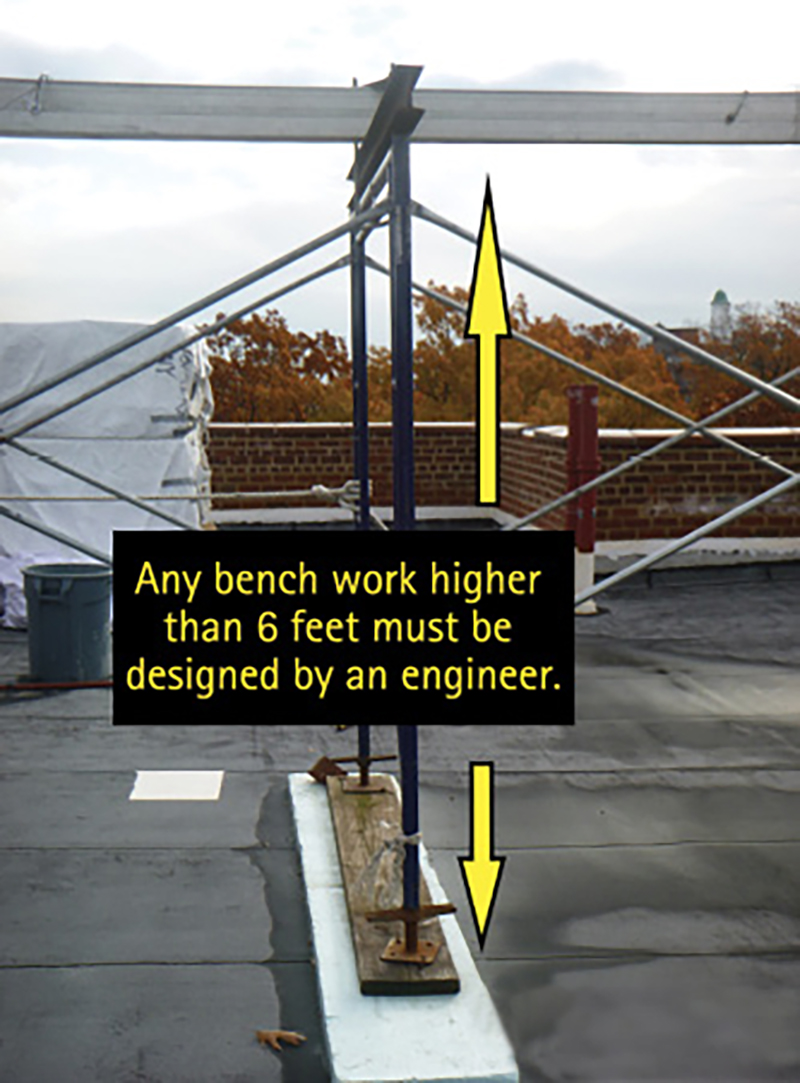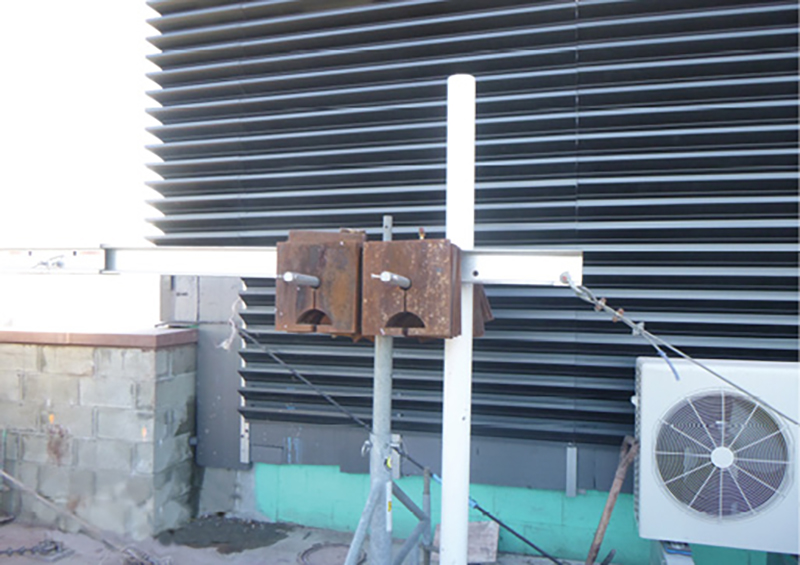When firefighters are in the firehouse and get a call for an elevated platform or a scaffolding emergency, what do they picture? Is it something like photo 1, a worst-case scenario in which you could have a complete system failure with workers hanging by their safety harnesses with no ability to bear any of their body weight on the platform? Or do you picture something like photo 2, in which the platform may be at a 45° angle parallel to windows and the workers just need be helped from the platform through the window to the inside of the structure? Maybe this offset of the platform resulted from a medical emergency happening to the worker who was operating the hoist, an electrical problem, or a failure in the scaffold system’s foundation.
- Common Roof Anchoring for Temporary Swing Stage Scaffolding
- Scaffolding on Buildings and its Effects on Firefighting Operations
- Responding to Suspended Scaffold Emergencies

(1) Photos by author.

(2)
Initial Plan of Action
In either situation, you need a plan of action. Swing-stage scaffolding is a set of components that form a scaffolding system. The platform stage that swings from a building is suspended by either ropes or cables connected to stirrups on these platforms. The platform stage is used to transport workers and their tools and materials to a certain building height to perform work. This is a very simple definition; in reality, it is much more complex. Our basic, simple plan should always start with the foundation, which, as in rope rescue, is the most important part of the system. The foundation in rope rescue is where we will anchor our main line, belay lines, tandem lines, and possibly mechanical advantage systems. The swing-stage scaffolding foundation includes the outrigger beams, the bench work, the counterweights, the tiebacks and anchors, and the structure’s roof. Our foundation is always located on the roof of the structure when we are talking about a swing-stage scaffold. Knowing where our foundation is now helps us develop a plan of action and steps to follow to ensure a safe and effective rescue operation.
Up to the Roof
Since we know that the foundation is on the roof of the structure, first send two firefighters from a support company to locate where the swing stage is getting its power. Most swing-stage scaffolding is hard wired into the electrical panels in the basements. So, before doing anything else, have them lock-out/tag-out the box.
At the same time, send two firefighters with rescue or squad experience to the roof with two rope bags, complete with rescue components for a main line, belay line, or tandem lines, along with a fire department radio with holster. First, they should attempt to communicate to the victims on the platform. The radio works great for this and can be lowered to the victims by one of the ropes. Make sure the power to the radio is on and that it is on the correct channel for communications.Place the radio on a channel designated for the victims as opposed to the operations channel to reduce radio traffic on the ops channel. One of the roof firefighters will remain on the victim’s channel and the other roof firefighter will stay on the operations channel so they miss no information and can relay any pertinent information to the operations chief or officer.
Once communications are established, the two roof firefighters must evaluate the foundation and determine if any components on the roof have caused the victim’s situation. Remember, the components include outrigger beams, bench work, counterweights, tiebacks with anchors, and the structure’s roof.
Outrigger Beams
The steel or aluminum alloy outrigger beams on the roof are used to suspend the platform (photo 3). They may be made from one-piece, spliced, and telescopic sections. The one-piece section is usually in 12- to 20-foot lengths; spliced sections are eight feet long and can be built up to 32 feet long. Steel outrigger beams can be either standard I or H beams or square or rectangular tubes. Regardless of the beams’ construction material, if the roof firefighters see that an outrigger beam is broken, cracked, bent, or fallen, they need to relay that information to the incident commander (IC) or the officer. This defective beam must be secured to an anchor.

(3)
Bench Work
Next, examine the bench work. Bench work is not always present with swing-stage scaffolding, but if it is, you should know how to handle it and what it looks like. Bench work is a platform that is built up to allow the outrigger beam to clear the wall or parapet (photos 4, 5). In photo 4, the bench work is less than six feet tall, allowing the outrigging to clear the parapet. In photo 5, since the bench work is more than six feet tall, it should be designed and stamped by a professional engineer. If the roof firefighters notice that the bench work has fallen or is unstable, they must report this to the IC or officer immediately; it may be only a matter of time before the rest of that section comes down and the outrigger beam is rendered useless.

(4)

(5)
Counterweights
Counterweights can be placed in numerous positions on a swing-stage scaffolding system and are always located on or attached to the outrigger beam. They may be attached to the end of the beam by a shackle and frapping line and rest on a wood plank on the structure’s roof (photo 6). The plank distributes the weight along the roof to avoid concentrating it in one area. It’s the same reason a roof ladder is placed at the ridge pole and laid down to the eaves when cutting the roof—to better distribute the firefighter’s weight. Counterweights are also found on horizontal stanchions from the outrigger beam (photo 7) and on the outrigger beam itself in the back (photo 8).

(6)

(7)

(8)
Most of the time, in this type of incident, the counterweights are almost never the issue. However, if you see the weights have fallen through the roof, obviously let the IC know so he can plan accordingly. Since the counterweights are holding the outrigger beams down on the frame or bench work, it is imperative that the firefighters on the roof tie back or secure the outrigger beam to something structural on the roof. This may include the use of grip hoists or come-alongs.
Tiebacks
Finally, the roof firefighters need to look at the tiebacks from the outrigger beams to a substantial object. Tiebacks must use 5⁄16-inch wire rope (the same size wire rope as the suspension rope), be attached to the outrigger beam shackle with at least three wire clamps (photo 9), and be anchored to a substantial object.

(9)
If a professional engineer designed the tieback, the tieback can be attached to a parapet clamp on the parapet (photo 10). We understand all the dangers of a parapet and we should tie back the outrigger to a substantial object but, in this field, this is allowed provided that a professional engineer has designed it. That said, if the firefighters notice that the tieback has failed, they must secure the outrigger beam with a rope and find a substantial object to which to anchor it. This could mean sending the rope to the back side of the building or one floor down to find a substantial anchor. Again, this will be based on the roof firefighters’ experience and rigging knowledge, which is why we would prefer to assign experienced firefighters to the roof to evaluate the situation. Advise the IC or officer of your situation and how you are going to correct the problem. This will help them in the decision-making process as the evolution progresses.

(10)
These are only the first two steps in a swing-stage scaffolding emergency response: lock-out/tag-out and two firefighters to the roof, which together should take only minutes. There are many other steps after these that we have not even begun to speak about; however, these first two should always be the same no matter what the swing-stage presents. It may look really serious at first, but if we perform these initial two steps quickly, we may be able to mitigate some of the problems and put ourselves and the victims in a better situation.
Final Points
- You must be constantly sizing up since the situation can be fluid.
- Communicate not only with your people but the victims too so they understand what is happening and what is going to happen.
- Safety is always your number one priority—safety for your people and safety for the victims.
- Prepare yourself and your department for this type of emergency; don’t let it surprise you! If you see swing-stage scaffolding going up in your area, stop by and get all the information you can. Start your preplan and share it with your department and neighboring and mutual-aid departments. Be proactive for these incidents.
Mike Giroux is a lieutenant in the Yonkers (NY) Fire Department with 22 years of service, mostly in Special Operations. He is a nationally certified fire officer and fire instructor. Giroux is responsible for all technical rescue and personal escape training in Yonkers. He has taught confined space, structural rope rescue, and collapse shoring throughout the country.

